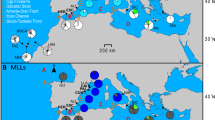Abstract
The effect of asexual reproduction on the population genetics of the fissiparous seastar Coscinasterias calamaria was examined at Rottnest Island and the adjacent mainland, Western Australia, in 1985. Field samples and laboratory observations on growth rate and regeneration showed that fission is common at all 14 sites examined. Electrophoretic analysis of six polymorphic enzymes revealed low genotypic diversity and strong genetic disequilibrium at each site, confirming the highly clonal structure of local populations. Striking variation in clonal composition over distances as short as 50 m emphasizes the very localized subdivision of these populations. In the combined sample from all sites, however, the expected range of multilocus genotypes was found in the proportions expected from random mixing of sexually produced larvae, confirming that clonal diversity results from sexual reproduction. Local genotypic diversity was not correlated with fission, emphasizing the difficulty of determining the short-term roles of asexual and larval recruitment in the maintenance of populations. Subtidal populations, however, appear to have both lower incidence of fission and lower larval recruitment than do intertidal populations.
Similar content being viewed by others
Literature cited
Ayre, D. J.: The effects of asexual reproduction and intergenotypic aggression on the genotypic structure of populations of the sea anemone Actinia tenebrosa. Oecologia 57, 158–165 (1983)
Ayre, D. J.: The effects of sexual and asexual reproduction on geographic variation in the sea anemone Actinia tenebrosa. Oecologia 62, 222–229 (1984)
Ayre, D. J. and J. M. Resing: Sexual and asexual production of planulae in reef corals. Mar. Biol. 90, 187–190 (1986)
Bell, G.: The masterpiece of nature: the evolution and genetics of sexuality. 635 pp. London: Croom Helm 1982
Black, R. and M. S. Johnson: Asexual viviparity and population genetics of Actinia tenebrosa. Mar. Biol. 53, 27–31 (1979)
Crump, R. G. and M. F. Barker: Sexual and asexual reproduction in geographically separated populations of the fissiparous asteroid Coscinasterias calamaria (Gray). J. exp. mar. Biol. Ecol. 88, 109–127 (1985)
Emson, R. H. and I. C. Wilkie: Fission and autotomy in echinoderms. Oceanogr. mar. Biol. A. Rev. 18, 155–250 (1980)
Fadlallah, Y. H.: Reproductive ecology of the coral Astrangia lajollaensis: sexual and asexual patterns in a kelp forest habitat. Oecologia 55, 379–388 (1982)
Heyward, A. J. and J. A. Stoddart: Genetic structure of two species of Montipora on a patch reef: conflicting results from electrophoresis and histocompatibility. Mar. Biol. 85, 117–121 (1985)
Hoffman, R. J.: Variation in contributions of asexual reproduction to the genetic structure of populations of the sea anemone Metridium senile. Evolution, Lawrence, Kansas 40, 357–365 (1986)
Li, C. C.: First course in population genetics, 631 pp. Pacific Grove: Boxwood Press 1976
Mladenov, P. V., S. F. Carson and C. W. Walker: Reproductive ecology of an obligatory fissiparous population of the seastar Stephanasterias albula (Stimson). J. exp. mar. Biol. Ecol. 96, 155–175 (1986)
Nichols, E. A. and F. H. Ruddle: A review of enzyme polymorphism and electrophoretic conditions for mouse and somatic cell hybrids in starch gels. J. Histochem. Cytochem. 21, 1066–1081 (1973)
Otteson, P. O. and J. S. Lucas: Divide or broadcast: interrelation of asexual and sexual reproduction in a population of the fissiparous hermaphroditic seastar Nepanthia belcheri (Asteroidea: Asterinidae). Mar. Biol. 69, 223–233 (1982)
Pearson, E. S. and H. O. Hartley: Biometrika tables for statisticians, 2nd ed. 240 pp. London: Cambridge University Press 1958
Shick, J. M., R. J. Hoffman and A. N. Lamb: Asexual reproduction, population structure and genotype-environment interactions in sea-anemones. Am. Zool. 19, 699–713 (1979)
Selander, R. K., M. H. Smith, S. Y. Yang and W. E. Johnson: Biochemical polymorphism and systematics in the genus Peromyscus. I. Variation in the old-field mouse Peromyscus polionotus. Stud. Genet., Austin, Tex. 6, 49–90 (1971)
Stoddart, J. A.: Asexual production of planulae in the coral Pocillopora damicornis. Mar. Biol. 76, 279–284 (1983a)
Stoddart, J. A.: A genotypic diversity measure. J. Hered. 74, 489–490 (1983b)
Stoddart, J. A.: Genetical structure within populations of the coral Pocillopora damicornis. Mar. Biol. 81, 19–30 (1984)
Williams, G. C.: Sex and evolution, 200 pp. Princeton: Princeton University Press 1975
Author information
Authors and Affiliations
Additional information
Communicated by G. F. Humphrey, Sydney
Rights and permissions
About this article
Cite this article
Johnson, M.S., Threlfall, T.J. Fissiparity and population genetics of Coscinasterias calamaria . Mar. Biol. 93, 517–525 (1987). https://doi.org/10.1007/BF00392789
Accepted:
Issue Date:
DOI: https://doi.org/10.1007/BF00392789




